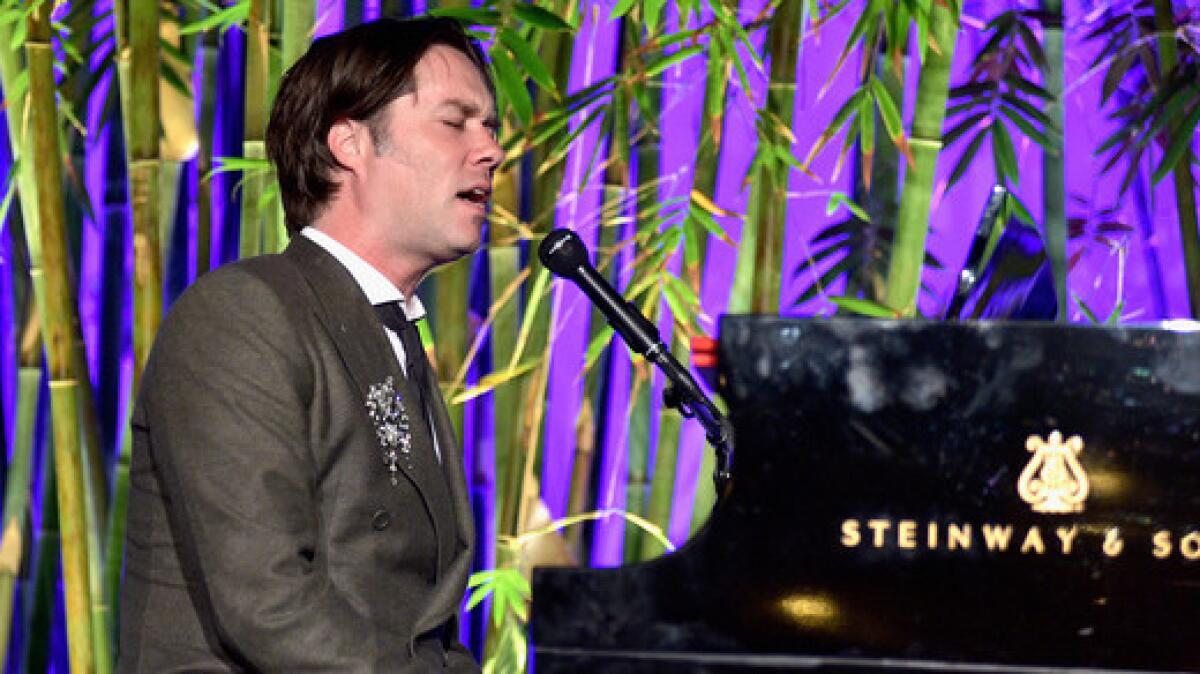Laurie Anderson and Todd Haynes are honored at Hammer Museum gala, where the talk turns political

- Share via
At the Hammer Museum’s annual Gala in the Garden fundraiser, Donald Trump and Hillary Clinton’s race for the White House dominated the cocktail chatter Saturday evening as A-list artists and museum officials mixed with a celebrity contingent that included recent Emmy winner Sarah Paulson, Emma Roberts and Will Ferrell.
The event, which netted more than $2 million for the Hammer, honored performance artist Laurie Anderson and filmmaker Todd Haynes. Both embodied a recurring sentiment during the evening: renewed conviction in the power of art to give voice to social and political issues of the day.
Talk of the recently released video of Trump making vulgar comments about women coursed through the largely liberal crowd. During a dinner of striped bass and kabocha squash, Norwegian novelist Karl Ove Knausgaard introduced Anderson and her performance on a midi violin and synthesizer. As she passionately sliced her violin bow across her body, over and over again, it cast elongated shadows across the stage’s backdrop of towering bamboo stalks bathed in green light.
After telling lively stories of running for student council president in junior high and exchanging letters with then-Sen. John F. Kennedy, Anderson turned more ominous. In a digitally modified voice that sounded like Darth Vader, Anderson referenced the presidential race as somber synthesizer music played in the background. “Of course, you ladies must not forget,” the deep, eerie voice threatened, “I can do whatever I want to you, whenever I want to do it. Why? Because I’m a star.”
The piece brought the audience to its feet.
“Her performance was topical, spot on and very, very brave,” artist Mark Bradford said. “There are times when politics and the art world can cross, and she did it seamlessly and elegantly and heroically.”
Artist Analia Saban was moved.
“It was so appropriate, the timing of it,” she said. “As a woman, without going into detail about anything or any candidate, the day before the debate, it was quite brilliant. And it reminds us of the power of art. It set the tone for the night and it made me believe in artists and what we do.”
Haynes, too, exemplified how art addresses social undertones of the day, though indirectly. Paulson, who appeared in Haynes’ 2015 film, “Carol,” introduced the filmmaker by talking about how Haynes purposefully “rumpled” her looks on set, raking his fingers through her hair and smearing her lipstick so that she would “look real.”
“As an actress, I felt an immediate sense of freedom,” Paulson said. “I didn’t have to think about my looks. And as a 41-year-old woman in an industry that often worships at the altar of youth and beauty, that was a real offering, a simple one but an utterly empowering offering.”
Haynes’ comments were more personal. A third-generation Angeleno, he talked about the film he just finished shooting, “Wonderstruck,” which he said was a tribute to the impact of cultural institutions on children’s creative lives. “Thinking about what has made me who I am, it’s impossible not to consider the cultural life of this city, which is a rich and fascinating one and the impact it made on me growing up.”
Hammer Director Ann Philbin explained, with an impish smile, why the museum chose Anderson and Haynes as its honorees: “Because they’re totally awesome.”
Ferrell jokingly recalled watching Anderson perform on “Saturday Night Live” and thinking, “That’s really, um, strange. Yeah, she’s gonna go somewhere!”
“Seriously, we’re big supporters of art in L.A., which is on an unprecedented roll,” added Ferrell, who is married to Hammer board member Viveca Paulin-Ferrell.
Board chairwoman Marcy Carsey said Anderson and Haynes were natural choices for the Hammer.
“They’re both so unique, their artistic sensibility is so specific, the kind of thing this museum admires,” she said. “It’s a little bit off the mainstream, it incorporates inclusiveness, progressiveness, the values that this museum is about.”
At the end of the evening, Rufus Wainwright performed three songs. Sitting at a grand piano, he said that at live events he typically likes to perform the song “Hallelujah.” But not tonight.
“I decided the next time I’ll play “Hallelujah” will be after Trump loses the election,” he said.
That ignited vigorous applause.
Instead, Wainwright performed his “Going to a Town,” with the recurring lyric, “I’m so tired of America.”
“They’re conveying what everyone’s feeling,” Hammer board member Mihail S. Lari said of Wainwright, Anderson and Haynes. “That’s the power of art. It brings people together and it gets to the soul of what’s important.”
Follow me on Twitter: @debvankin
ALSO
Ode to an avant-garde Japanese dance legend, performed with body and soul
‘Zoot Suit’s’ Luis Valdez on how Gordon Davidson brought civil rights to the American theater
Tacita Dean’s remarkable hand-drawn cloud prints at Gemini G.E.L.
More to Read
The biggest entertainment stories
Get our big stories about Hollywood, film, television, music, arts, culture and more right in your inbox as soon as they publish.
You may occasionally receive promotional content from the Los Angeles Times.











